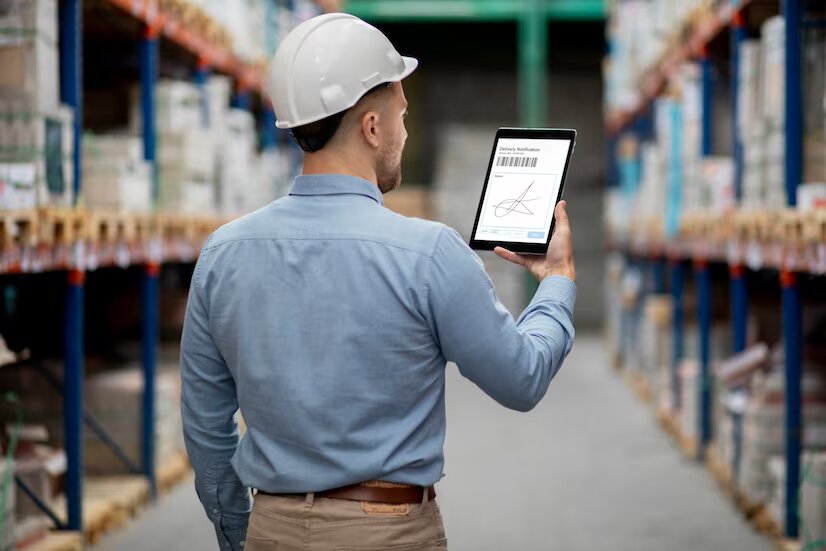Advanced Warehouse Tracking System: A Smart Investment For Your Business
5 Mins Read
Published on: 27 April 2023
Last Updated on: 13 November 2024

toc impalement
As e-commerce develops and marketplaces grow in popularity, there has been an increase in demand for warehouses as an essential element of the supply chain. The popularity of storage facilities is causing them to grow in size, which makes them difficult to manage. Many companies have implemented a warehouse management system (WMS) to automate processes and increase work efficiency. It can improve staff safety and solve a wide range of problems associated with operational speed and productivity.
What Is A Warehouse Management System (WMS)
WMS systems are a modern software solution that helps in optimizing and automating warehouse processes. When they are introduced, the warehouse is divided into zones that differ in the types of operations (acceptance, storage, shipment, etc.). All the arriving products are marked with barcodes or tags, and staff and loading equipment now have terminals for data input and output.
The software can automatically select places for storing products, generate tasks for staff, and also monitor compliance with the storage conditions. Additionally, a warehouse tracking system can be integrated, which allows you to monitor the movement of products, vehicles, and assets indoors. Thanks to this, WMS can monitor distribution centers around the clock and eliminate incorrect order picking or product placement.
The key advantage of the system is its wide array of features. With it, you can not only manage orders or stocks but also solve many other important tasks, including reporting, financial management, human resources, etc. In addition, WMS provides businesses with the following features:
- speeding up order picking;
- improving the efficiency of managing products with a limited shelf life;
- obtaining accurate data on the location of a particular product;
- optimizing warehouse space;
- improving cargo handling processes in warehouses.
The Features Of A Warehouse Management System
A warehouse tracking system is easy to set up and integrate within any warehouse. You can fully interact with it both within the corporate network and online. A platform for warehouse management usually performs the following tasks:
- Inventory management – stores data about suppliers and can create purchase orders for products. The system constantly monitors the balance of products in the warehouse, and after new ones come in, ensures their suitable placement. Additionally, the platform can provide various layout options for products based on their categories or characteristics.
- Order management – helps create lists of products needed, directs the employee to their location, and automatically selects the quantity and the type of packaging. With this software, you can calculate the cost of delivery and track packages along the way, as well as issue invoices to customers and even accept returns if necessary.
- Employee management – allows you to adjust work processes. Thanks to the system, you can accurately plan the number of workers needed in the warehouse space, track KPIs, and control security, including preventing theft. WMS determines the location of each employee in real-time and provides limited access to certain areas.
- Financial management – improves sales performance and helps evaluate the overall performance of the company. You can identify the most profitable customers, the most popular products, and the best-performing sales channels. The system minimizes any miscalculations of the company’s funds and helps save time.
- Reporting – provides detailed analytics and compiles automatic balance sheets that take into account taxes, profit volumes, and the cost of each product. The system can be integrated with accounting software and can support a wide range of additional features, such as shipping cost management or multi-currency pricing.
What Is A Warehouse Tracking System?
Recently, warehouse tracking systems (indoor tracking) have often been integrated into WMS, which allows you to track moving assets, products, and any other objects indoors. With them, you can determine the location of objects in real-time, control their movement, and also resolve many issues related to the inefficiency of warehouse operations or staff safety.
Warehouse movement tracking can be implemented based on various technologies, such as Bluetooth® Low Energy, UWB, Wireless Mesh, etc. When implemented indoors or on monitored objects, special beacons/tags are installed that help locate assets and transmit relevant data to a computer or a mobile application.
The key components of the system are the following:
- stationary infrastructure (sensors, readers);
- wearable equipment (bracelets, smart watches, smartphones, etc.);
- data processing software.
Through warehouse movement tracking, you can not only monitor the location of the equipment, but also prevent emergencies, adjust everyday tasks, and optimize the routes of warehouse equipment.
Problems That A Warehouse Tracking System Can Solve
Implementing a warehouse asset tracking system allows you to solve many different problems – from eliminating downtime of assets to the quick search for equipment and better order picking.
Equipment Downtime
Any business owner wants their resources to be used with maximum effect. But in reality, warehouses often face asset downtime, which occurs due to breakdowns or malfunctions. After implementing a warehouse tracking system, it’s possible to control the equipment and send it for preventive maintenance on time. The system regularly generates reports on the state of the vehicles and sends immediate notifications in case of improper operation, which allows for timely repairs and avoiding downtime.
The Long Search For Equipment/Vehicles
Sometimes warehouse employees have to spend a lot of time searching for assets, vehicles, and various equipment. It happens that forklifts are “lost” somewhere in the middle of the building, and carts or ladders are not where they should be. With a tracking platform, you can determine the location of any object. Using tags and sensors will let employees know where each asset is and save time searching for it.
Security Issues For Employees
Warehouse areas are classified as dangerous environments since their territory has a high risk of fires, floods, and injuries from falling objects, or collisions with warehouse equipment. Warehouse tracking systems improve staff security and provide the following features:
- tracking the time of entry and stay in restricted areas;
- emergency notifications;
- controlling the exit of all staff from the danger zone in case of an emergency;
- warning drivers about the proximity of people and the likelihood of a collision.
Inefficient Order-Picking Process
Searching for the necessary products takes a lot of time and can lead to employees making mistakes when collecting orders. When using the tracking system, it’s much easier to collect orders. Special indoor positioning algorithms can be embedded into it. With those, staff can easily build a route to any asset on the digital map included in the platform.
Ineffective Routes
Warehouse workers tend to walk in circles sometimes, especially in large areas, and spend a lot of time looking for products. After a warehouse tracking system is implemented, it’s possible to build an optimal route that will speed up warehouse operations and allow staff to avoid futile work. Developing short paths will be especially relevant when operating warehouse vehicles, as it helps with saving fuel and reduces equipment wear.
To sum up, WMS and warehouse movement tracks provide opportunities for the efficient optimization of warehouse space. They help speed up many operations, reduce the number of errors, and increase overall productivity. Forecasts show that soon, the digital supply chain will become the dominant model of any modern warehouse, so now is the time to invest in this technology and implement tracking solutions for your business.
Read Also:


















Comments Are Closed For This Article